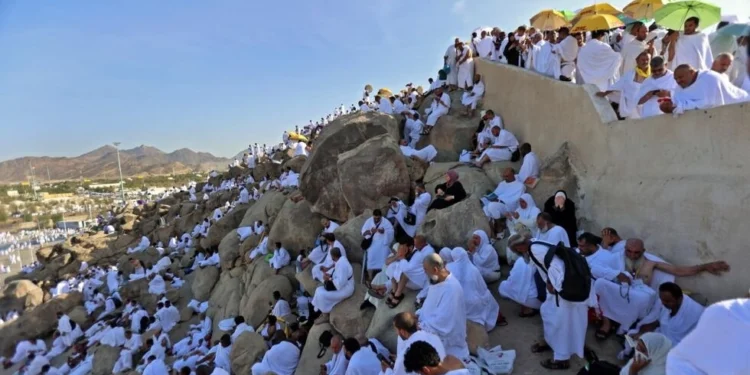More than 15 lakh Muslim pilgrims were in Mecca Friday for the start of a Hajj pilgrimage held in the backdrop of the Gaza war and in the soaring summer heat.
Today, all Muslims present will pray on Mount Arafat in exhausting temperatures, on the high-point and most grueling day of the annual Hajj pilgrimage.
Hajj Pilgrimage from all over the world will climb the rocky, 70-metre (230-feet) hill, about 20 kilometers (12 miles) from Mecca, where the Prophet Mohammed is believed to have given his last sermon.
The Saudi desert summer heat is expected to hit 43-44 degrees Celsius (109.4 degrees Fahrenheit), creating challenges especially among the elderly during prayer and reciting the Koran.
The Hajj, which takes at least five days to complete and is mostly outdoors, “is not easy because it is very hot”, said Abraman Hawa, 26, from Ghana.
“We have sun… but it is not as hot. But I will pray to Allah at Arafat, because I need his support,” she added.
Saudi authorities have urged pilgrims to drink plenty of water and protect themselves from the sun. Since men are prohibited from wearing hats, many carry umbrellas.
More than 10,000 heat-related illnesses were recorded last year, 10 percent of them heat stroke, a Saudi official told AFP this week.
READ MORE: Kate Middleton, recovering from cancer, shared an emotional post about her health
But the Gulf kingdom’s scorching summer sun did not put off Mohammed Farouk, a 60-year-old Pakistani pilgrim. The Hajj is “very important for me as a Muslim”, he said.
The enormous crowds of worshippers spent the night in a giant tented city in Mina, a valley several kilometers outside Mecca, Islam’s holiest city.
Many of them were tightly packed in air-conditioned tents, lying close together on narrow mattresses.
After Arafat they will head to Muzdalifah, where they will collect pebbles to carry out the symbolic “stoning of the devil” ritual in Mina on Sunday.
The Hajj is said to follow the path of the Prophet Mohammed’s final pilgrimage, about 1,400 years ago.
It is also a major financial windfall for the conservative country, which is trying to develop religious tourism as part of a drive to reduce its dependence on crude oil.
The Kingdom received more than 1.8 million pilgrims last year for the Hajj, around 90 percent of whom came from abroad.
It also welcomed 13.5 million Muslims who came to perform Umrah, the small pilgrimage that can be done all year round and aims to reach 30 million by 2030.
With inputs from Al Arabiya



 Pakistan Rupee Exchange Rate
Pakistan Rupee Exchange Rate




